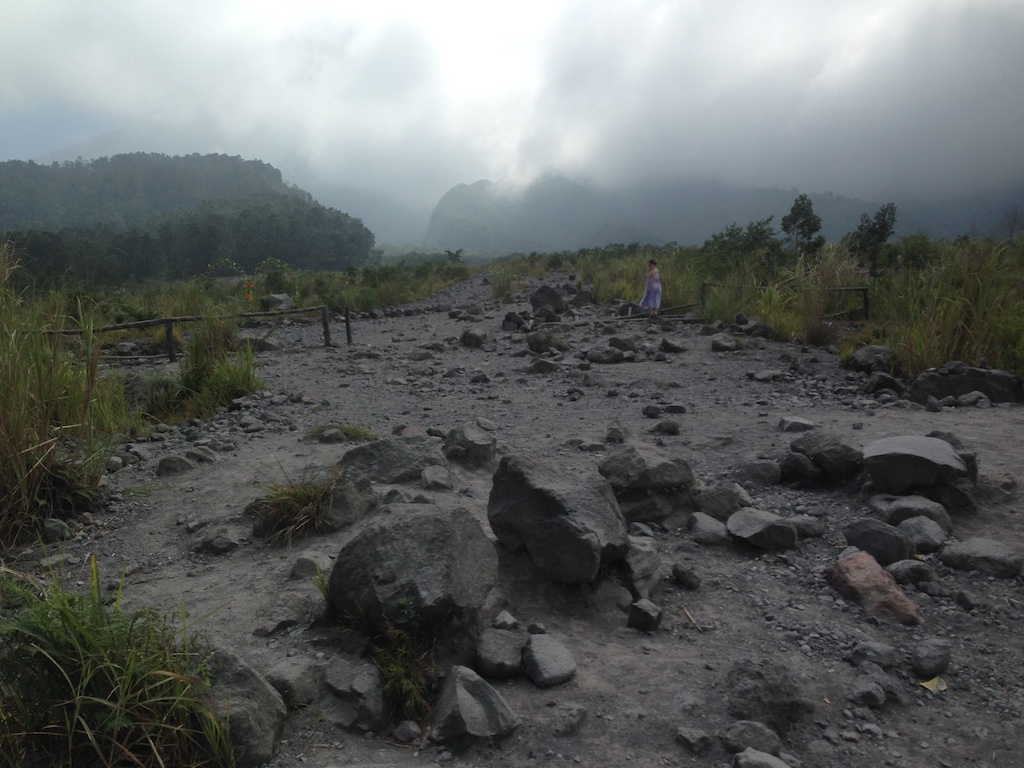So we went to Yogyakarta. Yogyakarta is a city in Indonesia, on the island of Java, a two-hour flight from Singapore. We had somehow never been to Indonesia; everyone goes to Bali, though we’ve been a little scared of that just because things that are over-touristed in Southeast Asia tend to be horrible: if we learned anything in Thailand, it was that. But we will inevitably end up in Bali at some point, it’s just something that happens to you when you live around here, like getting giardia. But this time we went to Yogyakarta. Yogyakarta is sometimes spelled Jogjakarta (maybe this is the name in Javanese?) and often abbreviated to Yogya or Jogja or Djogdja, but however you spell it you always say it with
But what is there in Jogjakarta? Well, there are a couple of ruins nearby, and there is Indonesia’s most active volcano, Mount Merapi. There’s also a lot of good food and a lot of art. But mostly we just wanted to look around and relax, which we mostly succeeded in doing. We did maybe pick the wrong time of year to do this? It’s Ramadan, which meant that there wasn’t as much food on the street as there’d usually be; on Tuesday it was Vesak day, a Buddhist holiday that was a good enough excuse for a lot of things to close, and the day we left was Pancasila Day, a national holiday.
Jogja is probably undertouristed? It seems like there are a lot of interesting young people doing interesting things there. Finding a way in is kind of tricky. A lot of the city is dirty, crowded, and overrun with motorcycles, like a lot of southeast Asian cities. It isn’t the best city for exploring by foot, but it does seem like there are some nice neighborhoods buried in it that one could find with a good guide. We did not have any such guide and so blindly stumbled around, occasionally finding nice things.
Here are some things that happened, though I think I have become worse at taking pictures on trips.
Prambanan
We went to Prambanan first. Prambanan is maybe less spectacular than Borobodur? But it’s also a little less touristed. It’s a complex of Hindu temples – about three hundred or so? – most of which are in disrepair but the main ones have been reconstructed and you can wander around them. It’s a nice place. Here is what is looks like, though other people have certainly taken better pictures than this:
The grounds are large and there are playgrounds and a couple of suburban temples you can look at. There’s a museum, I think, though we didn’t manage to find that. On the way out, we got distracted by a stand offering “traditional Javanese archery” which Harriet decided she was interested in. I am not sure how traditional Javanese archery differs from the ordinary kind of archery, though Harriet weirdly has a knack for it:
She would probably have spent all day there if we had arrived earlier, but the park was closing and we had to leave, to her great disappointment. Next time: arrive at Prambanan earlier. The reason we were at Prambanan so late was that one of the things that happens there is called in English the “Ramayana ballet” though whether the original Indonesian of Javanese actually corresponds to “ballet” I am not sure. But Harriet is a sucker for a good Ramayana performance, and it was the full moon so they were putting on a show. I am confused about exactly how this works but usually they split the Ramayana up into four two-hour chunks performed on consecutive nights; we somehow lucked out and got the whole Ramayana condensed into two hours. This is fine in front fi the temples with the moon in the background.
That is still, it has to be said, a lot of Ramayana. The way it works is that various characters dance on stage while a gamelan orchestra performs behind them; singers in the orchestra sing for the characters. (I think this is in Javanese? I could be wrong.) There are very occasional supertitles which inform the confused spectator who is who, though these appear about every five minutes, and time in between them can be confusing. The music is very nice. The dancing is a little shambolic, though clearly well-intentioned. Hanuman is of course the star, very acrobatic, and the high point is just before the intermission when he burns down Lanka (called here something like “Alengkha”) and immense straw walls are set on fire. This is a terrible picture because it was done with a telephone, but you can see the destruction and not the towers of Prambanan and the moon behind it.
I would recommend the Ramayana Ballet if yours is the sort of family that tends to argue about how exactly Jatayu is related to Garuda, as ours is, or if you actually know that. You should probably not do it if you have agreed to go to Borobudur for sunrise the next morning, as we did. But you can get your picture taken with Hanuman, like so:
Borobodur
Obviously it is a mistake to go anywhere for sunrise, and we should be smart enough to know that. But somehow we thought it would be a good idea to go see Borobudur at sunrise. This meant leaving the hotel at 3:30, which is not so great after you’ve been staying up late arguing about which talking bird is related to which in the Ramayana. Also this is kind of insane on general principles. Borobudur is not actually that far out of Yogya; so if you leave at 3:30 you still get there a good two hours before sunrise? When you climb to the top of Borobudur you discover that everyone is jockeying for position with their enormous tripods to film sunrise in such a way that it appears that no one else is there. The sunrise is beautiful from the top of Borobudur, though not mind-bendingly so. Through a crummy phone it looks like this:
Borobodur is a massive temple – it’s the largest Buddhist temple in the world. Some of us were not doing so well after waking up at 3:30 so we do not have any clean shots of how the whole thing looked, but it is something like this:
Part of the appeal of going there so early might be that even though there are a lot of people awaiting sunrise at Borobudur, there are less people than at other times: Borobudur is Indonesia’s most popular tourist attraction. It was not terrible compared to a lot of touristy things in Thailand.
The Borobodur grounds are large and we wandered them in a dazed state. Eventually we found the museum, which was not so great, though it did have a fish spa in the courtyard, which revived people’s spirits. Also it had this attractive rooster:
There was another rooster too who was black as sin and looked like he might be the very devil in chicken form. But I could not get a picture of him and you will have to imagine how terrifying he was.
Mount Merapi
Because of a series of questionable educational choices, Harriet has been very interested in volcanoes from a young age, and somehow knew, as I did not, that Mount Merapi, the volcano adjacent to Yogyakarta, was the most active volcano in Indonesia, which is no small honor. So she jumped at the chance to go see the volcano. So we took a van to a jeep and then bounced around in that up the side of Mount Merapi:
Mount Merapi periodically erupts, and theoretically Yogyakarta is in danger of being covered in lava. Small towns nearer the volcano have been fairly recently; we were taken to a museum where you could see, for example, what a volcano does to a typewriter:
I don’t know how close to the top we actually managed to get: it was foggy up there, but you can just make out the slope of the volcano in this one:
Never has a child been so excited to see an ex-lava-field:
Also because it was southeast Asia there was a guy with owls who let Harriet meet an owl:
We didn’t actually get to see any lava, so that was a disappointment, but it was still the best volcano that Harriet’s seen.
Yogyakarta in General
And we wandered around Yogyakarta a bit. It is full of cute coffee establishments which Harriet approved of:
The main tourist attraction in Yogya is the Sultan’s Palace, or Kraton, which was a bit underwhelming, even if it is enormous. There is still a sultan, and an interesting succession crisis going on right now; maybe the most interesting parts of the palace are private. There’s also Taman Sari, the water palace, which used to be the sultan’s baths:
Those are nice to wander around, though you’re not allowed to bathe in them. We also went through ARTJOG 2018, the annual (?) show at the National Museum of Yogyakarta, which had a lot of nice art, such as this crocheted seascape:
There are a lot of creative things going on in the city? It does seem like a guide would be useful, there are a lot of young people doing interesting things. We came across a guy who was building this in his front yard:
I don’t know what this is. Maybe it keeps out thieves.
Okay, this is too long. In summary: Yogyakarta is a fine place. The end.















































































































































